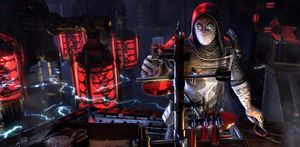Lore:Meet the Character - Arkasis
| Book Information | |||
|---|---|---|---|
| Source: | |||
This was written by senior writer Randy Begel.
From the recent publication, Investigator Vale Does Not Cry Wolf: The Truth Behind the Hounds of Black Moor, by Adandora, Chronicler-at-Large
The Hounds of Black Moor, one of the earliest Investigator Vale novels in the series, is considered instrumental in its widespread popularity. However, purists often criticize it as taking too many creative liberties and lacking the firm basis in reality that characterizes many of Vale's latter and more acclaimed adventures. Well, I'm here to tell you that those accusations are unfounded. It upholds the Vale series' reputation for being recountings of "true-to-life" adventures.
During my research into the origins of the series, which I thoroughly outline in The Real Investigator Vale, I uncovered accounts of mysterious disappearances that bore striking similarities to those described in the novel. Intrigued, I packed my travel bag and departed for Whiterun with all due haste.
The events in question occurred around 2E 577, when the city was terrorized by the baying of crazed outsiders and the howling of wolves that preceded nightly disappearances. Tensions within the city rose to a boiling point when a member of the Battle-Born family was found naked, covered in blood, and surrounded by dead livestock on the Gray-Mane estate. Accusations of lycanthropy and calls for executions nearly brought the situation to a head before a visiting stranger offered to investigate the matter and received the jarl's blessing.
Now, if you're familiar with the book (or don't mind having the ending revealed, if you aren't), Investigator Vale navigates the complicated dispute of two fictitious families under much the same circumstances. She, through her usual expert deductions, discovers that none of the alleged shapeshifters and crazed outsiders who came tearing through town like beasts suffered from the disease of lycanthropy, but they all had the same stains on their teeth. After much intrigue, deceit, and attempted murder, the cunning Vale catches the young court alchemist, Morhjartyr, in the act of poisoning the jarl with a beastly concoction that changed them into a terrifying werewolf. She chases her fugitive suspect back to his hideaway in Black Moor Keep, all while the ravenous jarl nips at her heels. All this culminates in a dramatic conclusion atop the keep's battlements, where Vale baits the overconfident Morhjartyr into a trap that knocks both him and the ravenous jarl from the high walls. Neither were ever seen again.
Much of this fateful encounter is not verifiable, but through exhaustive questioning and scouring of the local records, I uncovered that the unnamed stranger resolved the feud between the Battle-Borns and Gray-Manes, finding neither family at fault. Both the jarl and court alchemist vanished under mysterious circumstances during the upheaval, leading some to claim they co-conspired against the two powerful families. That remains purely conjecture, but it did not stop the newly ascended jarl from declaring Arkasis, the young alchemist, a menace of the highest order.
In the novel, Morhjartyr is never seen again and many presumed that he would return in a future entry as a formidable nemesis for the savvy Vale, but thus far the young alchemist has not reappeared in the author's works. However, the young fugitive, Arkasis, as it turns out, had more of a story to tell. I followed that name to three holds across the Skyrim, each with their own local legend of a mad alchemist who had been caught conducting unspeakable experiments on unwilling test subjects. These tests ranged from the lurid to the bizarre, involving strange alchemical substances and terrible transformations. Each time, this mad alchemist evaded justice and began anew, growing bolder in his work until he inevitably exposed his own misdeeds. To this day, he continues to elude capture. I believe these mad alchemists are all the same person—none other than the infamous Arkasis of Whiterun.
From all these sundry (and sometimes sordid) sources, I pieced together a picture of Arkasis from the flotsam of truth floating in the sea of fiction that surrounds him. First, he is in fact a man—a Nord like Morhjartyr, to be exact—who is rapidly approaching middle age. Of an unusually large stature, which I speculate is the result of profuse alchemical enhancement, Arkasis is described as a reclusive academic. He possesses a domineering and superior attitude toward others, seeing no one as his equal, yet he always seeks out sycophants to admire his own brilliance. This need for recognition always leads to his nefarious schemes coming to light. I can say, after hearing the tales told by the torch-wielding mob that chased him from their hold, that his experiments consist of ingenious designs with a blood-curdling disregard for suffering.
Coincidentally, the events described in the Hounds of Black Moor and those that plagued Whiterun itself happen to coincide with an unexpected delay in the travels of one Lady Arabelle Davaux, bound for Vvardenfell. I suspect that the reason we haven't seen the return of Morhjartyr in the Investigator Vale series stems from the fact that the author never uncovered what became of him herself. If you're reading this, Lady Arabelle, and wish to finally admit that you are the author and inspiration behind Vale, I would be absolutely willing to share what I've learned about the heinous crimes of one Arkasis, the Mad Alchemist. And all for the small price of that admission and a mention in your acknowledgements. Until then, the secrets of Morhjartyr—and Arkasis the Mad Alchemist—remain safe with me!
